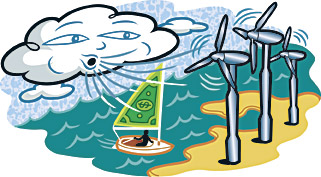A Mighty Wind:
For Wind Energy Investments, It’s the Potential That Counts
As the fastest-growing energy source in the world, abundant, safe, renewable wind power seems like a very promising investment opportunity. But Americans looking to jump on the wind bandwagon had best be careful, because no U.S.-based wind power companies are publicly traded. Adventurous investors willing to leave the comforts of the domestic stock exchanges behind, however, can look abroad.
 © Elizabeth Prager
© Elizabeth Prager
According to the American Wind Energy Association (AWEA), a record 6,868 megawatts (MW) of new wind power capacity was installed worldwide in 2002, bringing the total global capacity to more than 31,000 MW. By the end of 2002, U.S. wind energy capacity had grown to almost 4,700 MW, providing enough electricity to power three million homes. Twenty-seven states now host utility-scale wind power development. This industry growth can be attributed to a greatly reduced cost of production, an increased demand for clean, diverse sources of energy, and state and federal incentives. The average U.S. growth rate for the past five years is 24 percent, with still only a tiny fraction of the nation’s wind resources tapped.
The Sky’s the Limit
This untapped potential is why analysts are so jazzed about the future of wind power. According to Christopher Flavin of the Worldwatch Institute, "Even excluding environmentally sensitive areas, the global wind energy potential is roughly five times current global electricity use." Flavin adds that wind turbines installed on just 0.6 percent of the land area of the 48 contiguous states—mainly in the Great Plains—could meet 20 percent of current U.S. power needs.
The American wind energy market first began to surge in the 1980s, as three California-based turbine manufacturers—Kenetech (now bankrupt), Zond Systems (today a subsidiary of General Electric), and Seawest (still operating as a privately held company)—competed for dominance. These companies developed and installed thousands of technologically advanced wind turbines throughout the west.
In 1992, in an effort to further bolster the wind market on home soil, the U.S. government established the wind energy Production Tax Credit (PTC). Yet by structuring the credits to expire every couple of years, the government actually did a disservice to the wind industry. Congress has allowed the PTC to expire twice in the last five years, and it is set to expire again at the end of 2003.
"For the past decade, the wind industry has been on a roller-coaster caused by the two-year cycle of the PTC," says Randall Swisher, executive director of AWEA. "In 2002, the U.S. wind industry installed 410 MW. The year before that, we saw a record 1,700 MW of new wind power installed. With this instability, the industry does not attract the kind of investors we need."
Meanwhile, in Europe, government incentives have helped make wind power a booming business. Denmark, which initially led the global wind power renaissance of the 1970s, is the acknowledged world leader in the production of wind turbines. Today, the Danish companies Vestas, NEG Micon and Bonus account for more than half of all wind turbines installed throughout the world. Germany is the largest consumer of wind energy, and homegrown producers Enercon and Nordex dominate that country’s turbine manufacturing market.
While none of these European companies are listed on the NYSE or NASDAQ, they are publicly traded, and American investors can purchase their shares as over-the-counter stocks. If you’re interested, you should consult an experienced stockbroker.
U.S.-based mutual funds that include European wind firms in their portfolios, such as Progressive Investment Management’s Portfolio 21 fund, are perhaps a more circumspect option, as they offer the protection of a domestic investment but have the flexibility to invest internationally.
Energy analysts remain bullish on wind energy and expect it to expand significantly in the coming decades, both domestically and abroad. Savvy American investors willing to risk putting their money overseas could benefit by getting in early now. But when the economy turns around and the federal government works out the kinks in its wind power incentives program, some strong wind power players are sure to take the public markets by storm.

